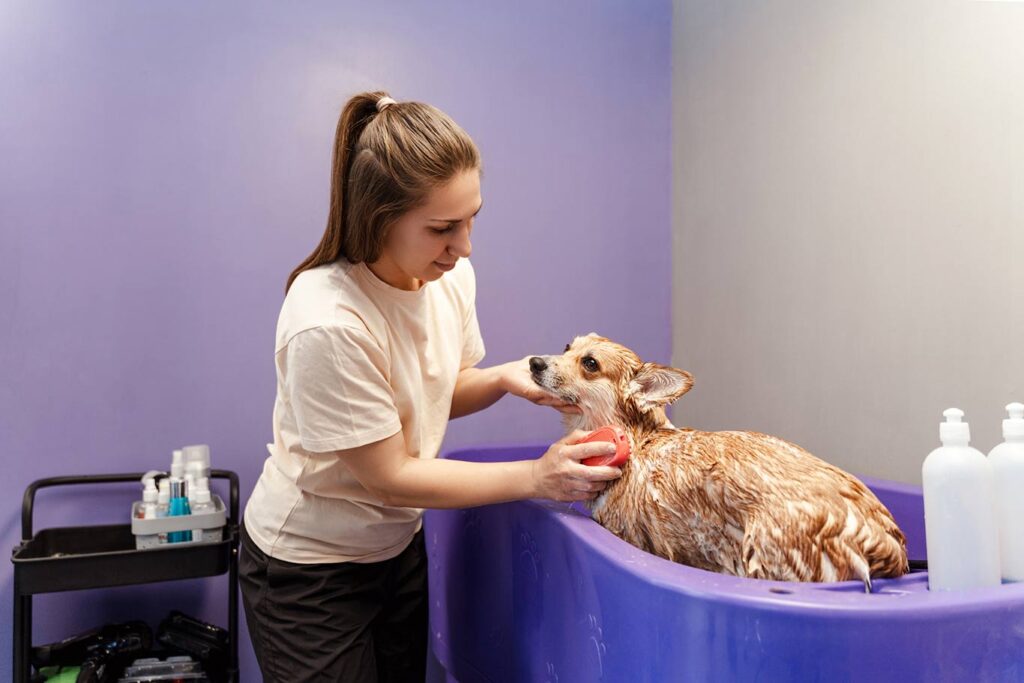Contributors
My main focus is managing the blog and product content for the Protectivity website ensuring everything aligns wi...
Canine experts have agreed that regular grooming is vital for their dog’s overall health and wellbeing. Imagine the joy of a dog bounding around after a refreshing grooming session, their coat gleaming and spirits lifted.
For those passionate about the welfare of our furry friends and looking to expand their dog grooming skills into a business venture, understanding the significance of professional grooming goes beyond aesthetics—it’s about nurturing a vital aspect of a dog’s life while offering a valuable service to their owners.
If you’re new to the world of dog grooming or are looking to expand your growing grooming service we’ve put together some tips on what skills can set a dog groomer up for success.
Understanding the Role of a Dog Groomer

Dog grooming is not just about making dogs look good; it’s a crucial aspect of canine health and wellbeing. Regular grooming helps prevent health issues such as skin infections, matting, and parasites. A dog groomer’s responsibilities are extensive, ranging from bathing and brushing to more detailed tasks like trimming fur, clipping nails, and cleaning ears.
To excel in this profession, a groomer must possess a blend of technical skills, patience, and a deep understanding of canine anatomy and behaviour.
Knowledge of Canine Anatomy and Behaviour
Understanding canine anatomy is fundamental for a dog groomer. Knowledge of the various breeds, their coat types, and specific grooming requirements is essential to ensure that each dog receives the appropriate care. Additionally, being familiar with canine behaviour helps groomers anticipate and respond to dog needs.
By recognising signs of stress or discomfort, such as body language cues or vocalisations, groomers can adapt their approach to ensure a positive grooming experience for the dog and build trust with both the pet and its owner. Patience is crucial, as groomers deal with different dog temperaments daily, requiring them to be calm and compassionate to address each dog’s needs and fears effectively.
Technical Proficiency
A successful dog groomer must be proficient in various grooming techniques, including bathing, brushing, trimming, and nail clipping. Staying updated with the latest grooming tools and techniques is vital to provide the best care and achieve optimal results for each dog. Here’s a dog grooming salon offering some tips:
Attention to Detail

Attention to detail is essential in dog grooming. It ensures the desired grooming results and helps in noticing subtle changes in a dog’s coat or skin, which can indicate underlying health issues. This vigilance can lead to early detection and treatment of potential health problems, so owners know when to get additional treatment for their pets’ wellbeing.
Effective Communication and Customer Service
Clear communication with pet owners is essential for understanding their preferences and concerns. Excellent customer service skills contribute significantly to client satisfaction and loyalty. Happy clients are more likely to return and refer others, which is vital for a grooming business’s success.
Building strong relationships with clients begins with clear and friendly communication. Groomers should be able to listen attentively to the pet owner’s preferences and concerns, while also providing professional advice and guidance when necessary.
Additionally, providing excellent customer service involves being responsive to enquiries, accommodating scheduling requests, and going the extra mile to exceed client expectations. By prioritising client satisfaction and maintaining open lines of communication, groomers can foster trust and loyalty, leading to repeat business and positive word-of-mouth.
Hygiene and Sanitation Practices
Maintaining high standards of hygiene and sanitation practices is crucial for a successful dog groomer. A clean and sanitary grooming environment not only ensures the health and safety of the pets but also reflects professionalism and care.
Using safe grooming products suitable for different dog breeds ensures that each dog receives the best care without risking adverse reactions. Grooming tools and equipment should be properly sanitised between each use to prevent the spread of bacteria and infections.
Additionally, grooming areas should be regularly cleaned and disinfected to eliminate any potential hazards or allergens. By focusing on hygiene and sanitation, groomers create a safe and comfortable environment for both pets and clients, enhancing their reputation and fostering trust in their services.
Building Trust and Relationships

Building trust and fostering relationships with both the dogs and their owners is a cornerstone of success for a dog groomer. Establishing a bond of trust with the pets ensures a positive grooming experience and allows the groomer to handle them with care and confidence.
Taking the time to interact with the dogs in a calm and reassuring manner helps to alleviate any anxiety or nervousness they may feel during the grooming process. Happy dogs lead to happy owners, and this trust can result in long-term client relationships.
Diverse Dogs, Diverse Needs
Recognising and addressing the diverse needs of dogs is also part of the job. With a wide variety of breeds, coat types, sizes, and temperaments, each dog requires unique care and attention during the grooming process. Groomers must be knowledgeable about the specific grooming requirements of different breeds, from the thick double coat of a Husky to the curly hair of a Poodle.
Furthermore, understanding the individual needs and preferences of each dog, such as their tolerance for grooming procedures or any health considerations, allows groomers to tailor their approach accordingly. By embracing the diversity of dogs and adapting their techniques to suit each pet’s needs, groomers can ensure a positive grooming experience for every furry client, regardless of breed or background.
Establish a good routine
A successful dog groomer starts with establishing a good routine, where time management is key. Balancing appointments, grooming sessions, and clean-up times efficiently ensures that every dog receives the care and attention they deserve.
A well-organised schedule not only enhances productivity but also reduces stress for both the groomer and the dogs. By prioritising tasks and allocating sufficient time for each grooming session, a groomer can maintain a steady workflow, avoid overbooking, and deliver consistent, high-quality service to their furry clients.
Avoiding Common Dog Grooming Mistakes
Essential Tools for a Successful Dog Groomer

Equipment
Quality grooming tools are essential for achieving professional results. This includes clippers, scissors, brushes, combs, and nail trimmers tailored to different coat types and grooming needs.
Grooming Products
Using high-quality shampoos, conditioners, and grooming sprays suitable for various coat types ensures a thorough and gentle grooming experience.
Cleaning Supplies
Maintaining a clean and hygienic grooming environment requires a range of cleaning supplies such as disinfectants, pet-safe detergents, and grooming table sanitisers.
Computer/Tablet/Phone
Digital devices are indispensable for managing appointments, communicating with clients, and accessing online resources such as grooming guides and product reviews.
Digital Platforms
Don’t ignore digital platforms such as social media, websites, and online booking systems which can help groomers market their services, engage with clients, and streamline administrative tasks.
Insurance
Securing comprehensive liability insurance protects groomers against potential accidents or legal issues, animals can be unpredictable so having this safeguard can provide peace of mind and financial security.
A successful dog groomer’s daily routine revolves around ensuring safety during grooming sessions. Mastering technical tasks, handling dogs with compassion, communicating effectively with pet owners, and maintaining rigorous hygiene protocols.
As a further safeguarding tip, make sure you also stay on top of Dog Grooming Business Legislation. Here we’ve put together an overview on the main laws for dog groomers.
Get Dog Grooming Insurance with Protectivity
Protectivity provides comprehensive, affordable dog grooming insurance for professionals just like you, whether you’re just starting out or have years of experience. Our policies encompass Public Liability that covers injuries or property damage; Care, Custody and Control cover of up to £100,000 in case a dog gets ill or injured, and up to £30,000 of specialist cover for your equipment.
With our insurance, available through flexible payment plans, you can groom dogs with confidence that an accidental error won’t hit you in the pocket. We cover all kinds of pet businesses including insurance for dog walkers, pet sitters, mobile pet taxis and more.
Get Dog Grooming Insurance from Protectivity
*Disclaimer – This blog has been created as general information and should not be taken as advice. Make sure you have the correct level of insurance for your requirements and always review policy documentation. Information is factually accurate at the time of publishing but may have become out of date.
Last updated by





























